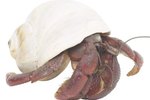
Exotic pets from far off lands get so much attention that you might forget about some of the many fascinating freaks of nature that live right under a brick in your back yard. Roly-polies are harmless little armored creatures who serve important decomposing functions in most terrestrial habitats. Content to hide with a dozen or so of their kind under a piece of bark, emerging only to explore and snack on a piece of fruit, roly-polies are undemanding pets.
Roly-Poly Basics
Roly-polies, known to scientists as isopods, are tiny terrestrial crustaceans who live under logs and stones and within the leaf litter of most terrestrial ecosystems. Of the more than 10,000 species found worldwide, each has sessile eyes, 10 legs, a set of large antennae, a set of small antennae and three primary body parts: head, thorax and abdomen. The thorax itself is further divided into seven individual segments. While most isopods will defend themselves by curling up slightly, in many species, the head and abdomen do not touch.. Some -- members of the family Armadillidiidae -- defend themselves by rolling into a tight ball, which earned them colloquial names such as roly-poly and pill bug.
Caging
Roly-polies do not require much space. A 10-gallon fish tank or similarly sized plastic cage will provide enough for room for several of the critters. Roly-polies are gregarious in the wild and should be kept in groups. Use a tight-fitting screen lid to keep the roly-polies inside, and unauthorized hands and pets outside.
Lighting and Heating
It is not necessary or advised to provide supplemental lighting for captive roly-polies. In the wild, roly-polies live in dark places and tend to avoid brightly lit areas. Similarly, by living in locations sheltered from the sun, roly-polies are adapted to living at relatively cool temperatures. Typically, room temperature suits roly-polies well.
Substrate and Decorations
Place 1 or 2 inches of organic potting soil in the bottom of the cage. Press the soil down lightly, but do not compact it too much. On top of the soil, place about 1 inch of leaf litter -- you can collect leaf litter from under a hardwood tree in your back yard as long as pesticides have not been used near it. On top of the leaf litter, add a few pieces of flat bark, under which the roly-polies can hide. Rocks can easily crush the tiny critters, so avoid using them with your roly-polies.
Food
Roly-polies are detritivores who consume a wide variety of organic material. They primarily consume dead plants or animals, but they will occasionally eat live plants. In captivity, they will thrive on a diet of raw fruit and vegetable slices. Potatoes, carrots, apples and pears are good choices. Place the slices in the leaf litter and change them every few days, or sooner if the food begins to mold.
Water and Humidity
Roly-polies breathe via gills; accordingly, they must inhabit areas with high humidity in order to breathe. Roly-polies derive most of their necessary water from the humid air and their food. Mist your captives' enclosure daily with lukewarm bottled water. Spray the leaf litter and cage sides thoroughly, but try not to let puddles develop or saturate the substrate. Do not provide your roly-polies with a water dish, as it is not necessary and presents a drowning hazard.
References
Resources
Photo Credits
-
Jupiterimages/Photos.com/Getty Images




